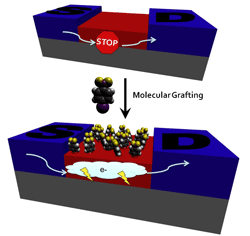Process reaches beyond the limits on Moore’s Law
Attaching molecules to the surface of silicon could be a boon to electronics manufacturers
A team of researchers from Rice University and North Carolina State University have announced a new process of attaching molecules to semiconducting silicon. This method could help electronic manufacturers reach beyond the current limits on Moore’s Law as they promise to make smaller and more powerful microprocessors.

Attaching molecules to semiconducting silicon affects the threshold voltage, or gate voltage, required to create a conductive path between the source and drain electrodes (blue) and turn the device on. The molecules influence the amount of charge carriers available within the device layer (red).
Moore’s Law states that the number of transistors that can be placed on an integrated circuit doubles about every two years. As electronic manufacturers pack more transistors onto integrated circuits by making the circuits even smaller, the problem becomes doping — a process that has been essential to creating the silicon substrate that is at the core of today’s integrated circuits.
So the team’s challenge was to get past the limits of doping. Doping introduces impurities into pure crystalline silicon as a way of tuning microscopic circuits to a particular need, and it’s been effective so far even in concentrations as small as one atom of boron, arsenic, or phosphorus per 100 million of silicon.
The team suggests that by attaching molecules to the surface of the silicon (rather than mixing them in) affects the threshold voltage, or gate voltage, required to create a conductive path between the source and drain electrodes (blue) and turn the device on. The molecules influence the amount of charge carriers available within the device layer (red). This method serves the same function as doping, but works better at the nanometer scale.
James Tour, Rice’s Chao Professor of Chemistry, anticipates a wide industry interest in the process, in which carbon molecules could be bonded with silicon either through a chemical bath or evaporation.
The paper on this research can be found at http://pubs.acs.org/doi/abs/10.1021/ja9002537. For additional information, contact Mike Williams of Rice University at 713-348-6728 or e-mail mikewilliams@rice.edu.
Christina Nickolas
Advertisement
Learn more about Rice University





